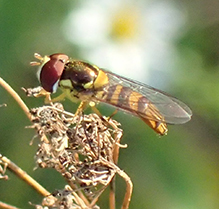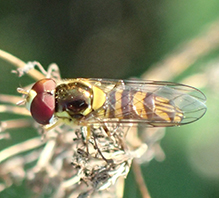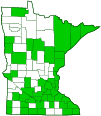oblique streaktail
(Allograpta obliqua)
Conservation • Description • Habitat • Ecology • Distribution • Taxonomy
|
|
||||||||||||||
Description |
Oblique streaktail, also called common oblique syrphid fly, is a small typical hover fly. It occurs in North America, Central America, and South America. It is widespread, common, and abundant in the continental United States, but it is mostly absent from the northwest. It is common in Minnesota. Adults are found from June through September in a wide variety of habitats. They take pollen and nectar from a wide variety of flowers. The larvae are predators of mites, whiteflies, mealybugs, butterfly larvae, jumping plant lice eggs, and at least 50 species of aphids. Adults are 3⁄16″ to ⅜″ (5.4 to 9.0 mm) in length. The body is slender, somewhat elongated, thinly hairy, and black with yellow markings. The head is small, hemispherical, narrow, and yellow. The back of the head is strongly concave and closely appressed to the front of the thorax. There are two large compound eyes on the sides of the head and three small simple eyes (ocelli) in a triangle on top of the head. The compound eyes are bare, with no erect hairs. On the male they abruptly converge and meet at the top of the head in front of the ocelli. On the female they do not meet. When viewed from the side, the antennae are in the middle of the head. They have three segments and are short, shorter than the head. The first two segments (scape and pedicel) are not longer than wide. The third segment (flagellum) is oval and at most twice as long as wide. At the base of the flagellum there is a long, forward-pointing bristle (arista) on the upper side. The face is yellow. It does not project forward but there is a rounded bump (tubercle) at the bottom. The face sometimes has an opalescent, dusky, dark brown, or black vertical stripe in the middle from the ocelli to the tubercle, but this is often missing. The protruding mouthpart (proboscis) is short and fleshy. The thorax is covered with erect, golden-yellow hairs. The large front portion (scutum) is entirely black and shiny. There is an ash gray linear stripe in the middle above and a yellow stripe on each side. On the side of the thorax there are several yellow plates (sclerites), including a large spot before the wing bases, that together form a continuous yellow band from the front to the rear. On each side of the scutum, in the shoulder (humeral) area just behind the head, there is a small plate (postpronotum). The postpronotum is yellow and bare, with no hairs or bristles. Unfortunately, this is not visible without first removing the fly’s head. The small plate at the rear part of the thorax (scutellum) is yellow. The abdomen is parallel sided and mostly black above and on the sides. On the male, the fifth abdominal segment (tergite) is visible from above, a feature that distinguishes the subfamily Syrphinae. The first tergite is short and yellow with a black band at the rear margin. The second tergite has a narrow yellow band on the front margin that is broken in the middle, and a broad, complete, yellow band in the middle. The third tergite has a broad, yellow, arced band in the middle. The fourth and fifth tergites have two yellow stripes in the middle and a large, oblique, oblong, oval spot on each side. The wings are mostly clear except for a smoky brown region (stigma) on the leading edge. There is a false (spurious) vein between the radius (R) and media (M) veins. The anal cell is long and is closed near the wing margin. The marginal, R5, and M2 cells are also closed. There are two membranous lobes (calypters) at the base of each wing that cover the balancing structure (haltere). The calypter is brown above and there are long yellow hairs on the upper surface. This feature may require a hand lens or microscope to see. The legs are almost entirely yellow. On the hind legs of the male, the third segment (femur) has a dark ring near the tip, the fourth segment (tibia) is brown with a yellow ring in the middle, and the last part of the leg (tarsus), corresponding to the foot, is entirely dark. |
Size |
Total length: 3⁄16″ to ⅜″ (5.4 to 9.0 mm) |
Similar Species |
Habitat |
A wide variety of habitats |
Ecology |
Season |
June to September |
Behavior |
|
Life Cycle |
|
Larva Food |
Mites, whiteflies, mealybugs, butterfly larvae, jumping plant lice eggs, and at least 50 species of aphids |
Adult Food |
Pollen and nectar from a wide variety of flowers |
Distribution |
||
|
Sources TELFORD, H. S. 1939. The Syrphidae of Minnesota. Univ. of Minn. Agric. Exp. Sta. Tech. Bull. No. 140, 76 pp. |
|
| 9/15/2024 | ||
Occurrence |
||
Widespread, common, and abundant. |
||
Taxonomy |
|
Order |
|
Suborder |
Brachycera |
Infraorder |
Cyclorrhapha |
Zoosection |
Aschiza |
Family |
Syrphidae (Hover Flies) |
Subfamily |
|
Tribe |
Syrphini |
Genus |
Allograpta (streaktails) |
Subordinate Taxa |
|
|
|
Synonyms |
|
Allograpta dejongi Scaeva obliqua Syrphus bacchides Syrphus baccides Syrphus dimemsus Syrphus obliquus Syrphus securiferus Syrphus signatus |
|
Common Names |
|
common oblique syrphid fly oblique stripetail oblique streaktail |
|
Glossary
Arista
A large bristle on the upper side of the third segment of the antenna of a fly. Plural: aristae.
Femur
On insects and arachnids, the third, largest, most robust segment of the leg, coming immediately before the tibia. On humans, the thigh bone.
Ocellus
Simple eye; an eye with a single lens. Plural: ocelli.
Proboscis
The tube-like protruding mouthpart(s) of a sucking insect.
Scutellum
The exoskeletal plate covering the rearward (posterior) part of the middle segment of the thorax in some insects. In Coleoptera, Hemiptera, and Homoptera, the dorsal, often triangular plate behind the pronotum and between the bases of the front wings. In Diptera, the exoskeletal plate between the abdomen and the thorax.
Scutum
The forward (anterior) portion of the middle segment of the thorax (mesonotum) in insects and some arachnids.
Tarsus
On insects, the last two to five subdivisions of the leg, attached to the tibia; the foot. On spiders, the last segment of the leg. Plural: tarsi.
Tergite
The upper (dorsal), hardened plate on a segment of the thorax or abdomen of an arthropod or myriapod.
Tibia
The fourth segment of an insect leg, after the femur and before the tarsus (foot). The fifth segment of a spider leg or palp. Plural: tibiae.
Tubercle
On plants and animals: a small, rounded, raised projection on the surface. On insects and spiders: a low, small, usually rounded, knob-like projection. On slugs: raised areas of skin between grooves covering the body.
Visitor Photos |
||
Share your photo of this insect. |
||
This button not working for you? |
||
Alfredo Colon |
 |
Babette Kis |
||
 |
 |
|
Allograpta obliqua (common oblique syrphid fly) Allograpta obliqua, common oblique syrphid fly, Barnes Prairie, Racine Co., WI photographed on October 10, 2020. |
||
MinnesotaSeasons.com Photos |
||
|
||
|
||

Slideshows |
|

Visitor Videos |
||
Share your video of this insect. |
||
This button not working for you? |
||
|
Other Videos |
||
Hoverfly (Allograpta obliqua) |
About
Feb 24, 2012 This male hoverfly has big red eyes and a nice pattern on its abdomen. I like the gold thorax too! This is of it cleaning itself while resting on a Hollywood Juniper. |
Hoverfly (Allograpta obliqua) |
About
Oct 11, 2011 This Hoverfly or Hover Fly has a cool pattern on the abdomen. You can see it flex its abdomen as it walks around and drinks water off the leaf and rose bud. |
Allograpta Obliqua || Common Oblique Hoverfly || Consuming Fennel Pollen and Nectar || 4K Video |
About
Premiered Mar 2, 2023 Allograpta Obliqua Common Oblique Hoverfly Consuming Fennel Pollen and Nectar 4K Video |

Visitor Sightings |
||
Report a sighting of this insect. |
||
This button not working for you? |
||
Alfredo Colon |
Location: Albany, NY |
 |
| Babette Kis 10/10/2020 |
Location: Barnes Prairie, Racine Co., WI Allograpta obliqua, common oblique syrphid fly, Barnes Prairie, Racine Co., WI photographed on October 10, 2020. |
 |
MinnesotaSeasons.com Sightings |
||
|

Created: 11/3/2023 Last Updated: © MinnesotaSeasons.com. All rights reserved. |
